Using Dependency Tracking to Provide Explanations for Policy Management
Lalana Kagal
Decentralized Information Group
MIT Computer Science and Artificial Intelligence Laboratory
Talk Outline
- Why do we need explanations ?
- AIR Policy Language
- Explanations in AIR
- Dependency tracking
- Explanation generation
- Automatic explanations
- Customizing explanations
- Problems & Future Work
Importance of Explanations
- Explanations for policy decisions allow users to understand how the results were obtained
- Increase trust in the policy reasoning and enforcement process
- Used by policy administrators to confirm the correctness of the policy and to check that the result is as expected
- In the case of failed queries, they can be used to figure out what additional information is required for success
Why aren't proofs enough ?
|

Image courtesy http://clip.dia.fi.upm.es/~logalg/slides/ |
AIR Policy Language
- rule-based policy language for accountability and access control
- explanations for policy decisions through dependency tracking
- customizable explanations, if required
- more efficient and expressive reasoning through the use
of goal direction
- mainly forward chaining
- backward chaining is used to limit search space
- grounded in Semantic Web technologies for greater interoperability, reusability, and extensibility
Dependency Tracking
|
AIR specifications
:Policy1 a air:Policy;
air:rule [
air:pattern { ... };
air:assert { ... };
air:rule [ ... ]
].
|
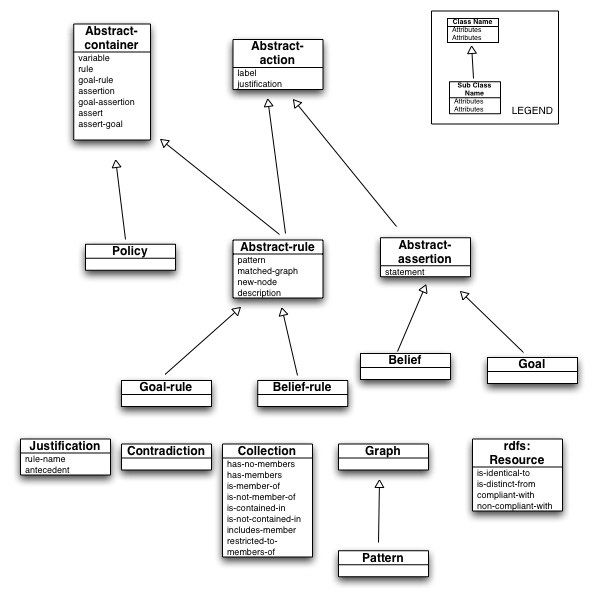
|
AIR specifications
- Variables (air:variable)
- used to declare variables that can be used inside patterns
- the scope of variable is the container in which it is declared. If the variable is bound before a rule is invoked, it is passed as a constant
- Rule descriptions (air:description)
- list of variables and strings that are put together to provide the NL description
:Policy2 a air:Policy;
air:variable :VAR1;
air:rule [
air:variable :VAR2;
air:pattern { ... };
air:assertion { ... };
air:description (:VAR1, “ is a variable that is declared in :Policy2 and ”, :VAR2,
“ is a variable that is declared in this rule”);
air:rule [ ... ]
.
AIR Tools
- AIR Reasoner
- accepts data + policy
- produces reasoning result of running policy over data
- Available via http
http://mr-burns.w3.org/cgi-bin/server_cgi.py?logFile="log file"&rulesFile="policy file"
- Justification UI
- accepts reasoning results
- Textual display
- Allows exploration of graphical display
- Firefox Extension: http://dig.csail.mit.edu/2007/tab/
Simple AIR Example
All DIG members are allowed to view resources owned by the DIG group

Viewing Policy in UI
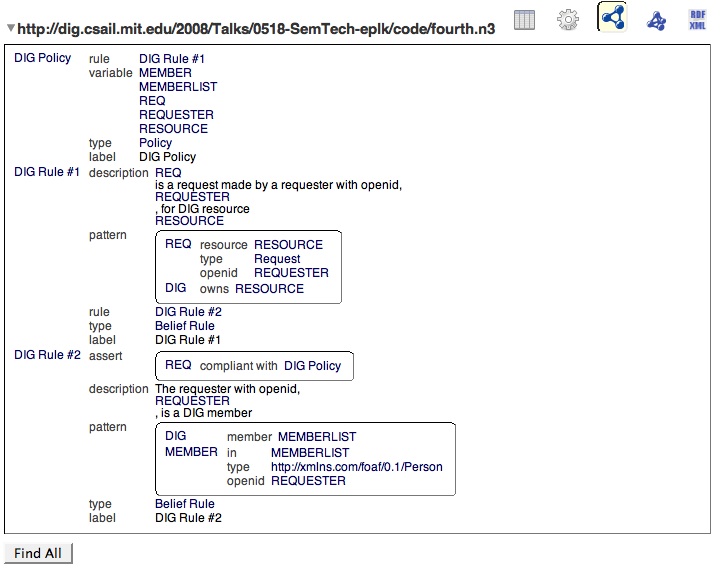
Explanation
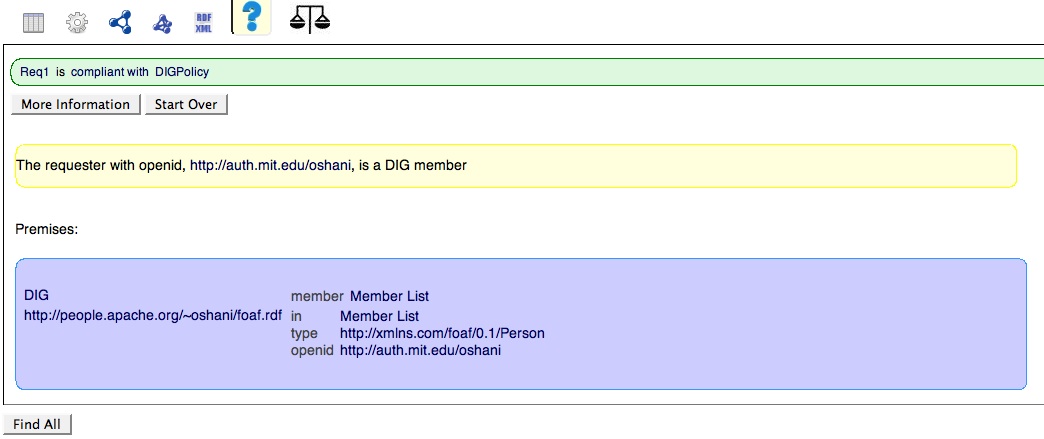
Explanation
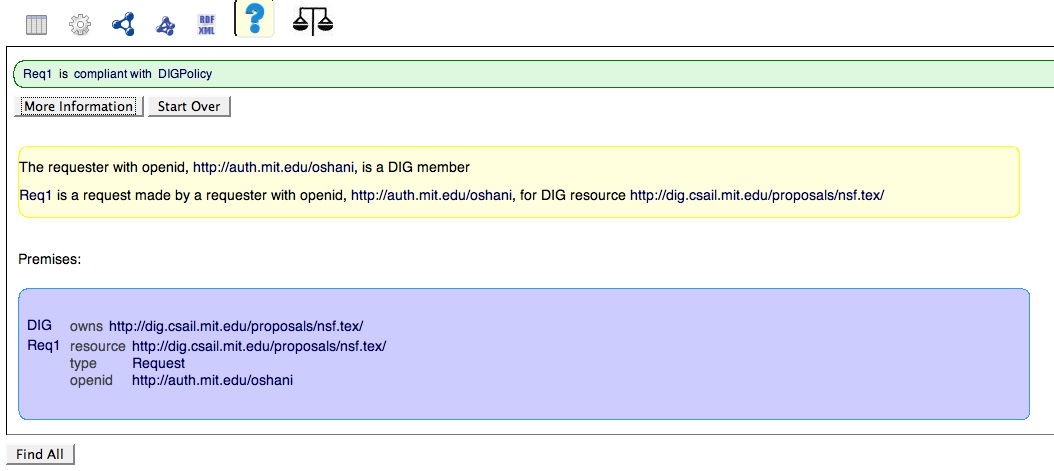
Generation of Explanations
- While reasoning, the reasoner maintains dependencies of all conclusions
- Rules in dependency sets annotated with NL descriptions
- Result of reasoning provided to justification ui
- Required conclusion identified
- Dependencies of conclusion extracted
More AIR Specifications
- So far we've seen air:Policy, air:variable, air:BeliefRule, air:pattern, air:description, air:assert
- Alternative rule (air:alt)
- It is a rule that becomes active if the pattern of the containing rule fails.
- This alt property is used to assert closure over some set of facts.
- Consider the following example. If the pattern of :RuleB matches, then the assertion fires, otherwise the alternative rule, :RuleC, becomes active.
:RuleB a air:Belief-rule;
air:variable :MEMBER;
air:pattern {
:MEMBER air:in :MEMBERLIST.
};
air:assert { :MEMBER foaf:member :DIG };
air:alt [ air:rule :RuleC ].
:RuleC a air:Belief-rule;
Alternative rules
- Extending original policy
- If the requester is not a DIG group member, then check if the requester is known to any of the DIG members.
- This rule is an alternative to rule, DAP-2, defined earlier
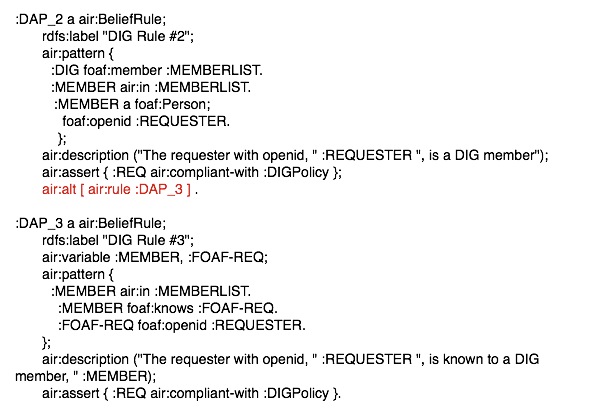
Viewing Policy in UI
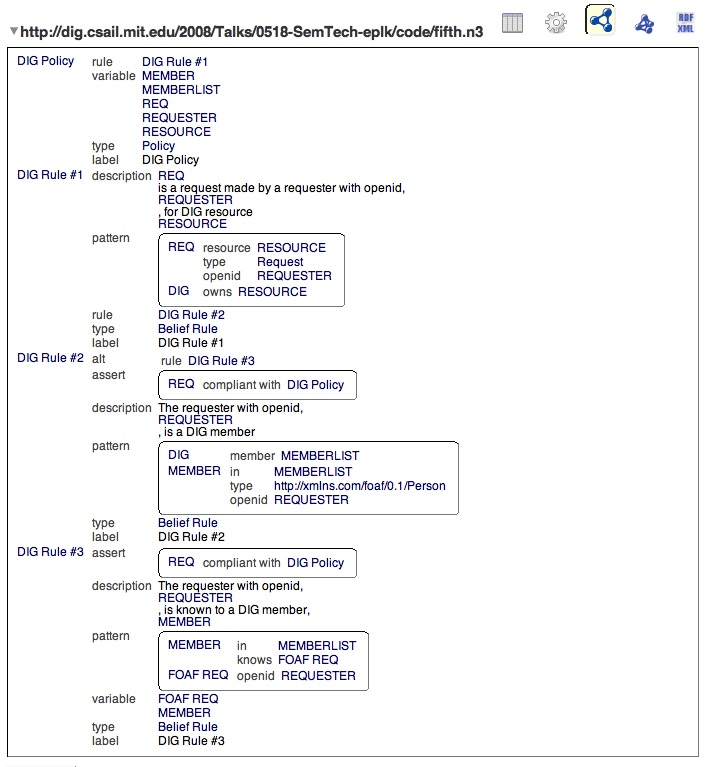
Customizing Explanations
Why
- Using dependency tracking, we are able to generate explanations for every conclusion reached by the reasoner
- Explanation is too lengthy - we might want to reduce the number of steps
- Explanation exposes too much information about the policy - we might want to protect our policy
Customizing Explanations
How
- Hidden rules: Prevents the deduction steps of the rule from
appearing in the explanation
:RuleB a air:Hidden-rule; - Rule descriptions: Lists of variables and strings put together
to form NL descriptions of rules
:DAP-2 a air:BeliefRule; air:description ("The requester with openid, " :REQUESTER ", is a DIG member").
Customizing Explanations
How
- Modify dependencies: use air constructs to change the actual
dependencies of a conclusion
- instead of air:assert, air:assertion property of rules is used
- air:assertion is of type air:Assertion
- air:Assertion class is composed of two components
- air:statement, which is the set of triples being asserted
- air:justification, which is the explicit justification that needs to be associated with the statement. It is of type air:Justification
- air:Justification class consists of two properties
- air:rule-id, which can be set to the name of the rule that the assertion is to be attributed to
- air:antecedent is a list of matched graphs that would act as the premises. It is possible to obtain the matched graphs of rules by using the matched-graph property of Rules with a variable.
Customizing Explanations - Example
|
Original Policy 
|
Modifying Dependencies 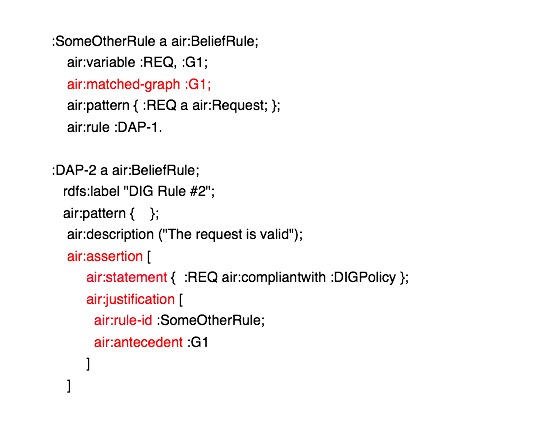
|
Original Explanation

Customizing Explanations - Example

Future Work
- Unhelpful explanation generated for alternative rule
- Multi-level rule descriptions
- Pattern matching is not scalable
- Some firefox issues with justification UI
Summary
- AIR Policy language
- explanation generation
- dependency tracking
- mechanisms for customized explanation
- AIR tools
- AIR reasoner
- Justification UI
More Information
- AIR specifications: http://dig.csail.mit.edu/TAMI/2007/AIR/
- AIR ontology: http://dig.csail.mit.edu/TAMI/2007/amord/air.ttl
- Demo: http://dig.csail.mit.edu/2008/Talks/0518-SemTech-eplk/code/
- How to use the Justification UI http://dig.csail.mit.edu/TAMI/2008/JustificationUI/howto.html
